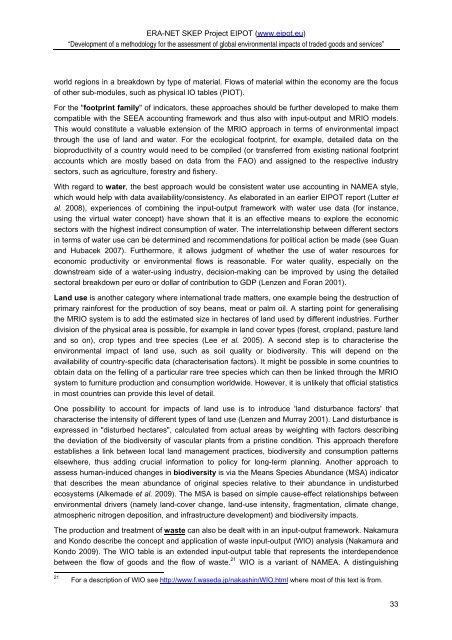EIPOT Final Project Report - Stockholm Environment Institute
EIPOT Final Project Report - Stockholm Environment Institute
EIPOT Final Project Report - Stockholm Environment Institute
You also want an ePaper? Increase the reach of your titles
YUMPU automatically turns print PDFs into web optimized ePapers that Google loves.
ERA-NET SKEP <strong>Project</strong> <strong>EIPOT</strong> (www.eipot.eu)<br />
“Development of a methodology for the assessment of global environmental impacts of traded goods and services”<br />
world regions in a breakdown by type of material. Flows of material within the economy are the focus<br />
of other sub-modules, such as physical IO tables (PIOT).<br />
For the "footprint family" of indicators, these approaches should be further developed to make them<br />
compatible with the SEEA accounting framework and thus also with input-output and MRIO models.<br />
This would constitute a valuable extension of the MRIO approach in terms of environmental impact<br />
through the use of land and water. For the ecological footprint, for example, detailed data on the<br />
bioproductivity of a country would need to be compiled (or transferred from existing national footprint<br />
accounts which are mostly based on data from the FAO) and assigned to the respective industry<br />
sectors, such as agriculture, forestry and fishery.<br />
With regard to water, the best approach would be consistent water use accounting in NAMEA style,<br />
which would help with data availability/consistency. As elaborated in an earlier <strong>EIPOT</strong> report (Lutter et<br />
al. 2008), experiences of combining the input-output framework with water use data (for instance,<br />
using the virtual water concept) have shown that it is an effective means to explore the economic<br />
sectors with the highest indirect consumption of water. The interrelationship between different sectors<br />
in terms of water use can be determined and recommendations for political action be made (see Guan<br />
and Hubacek 2007). Furthermore, it allows judgment of whether the use of water resources for<br />
economic productivity or environmental flows is reasonable. For water quality, especially on the<br />
downstream side of a water-using industry, decision-making can be improved by using the detailed<br />
sectoral breakdown per euro or dollar of contribution to GDP (Lenzen and Foran 2001).<br />
Land use is another category where international trade matters, one example being the destruction of<br />
primary rainforest for the production of soy beans, meat or palm oil. A starting point for generalising<br />
the MRIO system is to add the estimated size in hectares of land used by different industries. Further<br />
division of the physical area is possible, for example in land cover types (forest, cropland, pasture land<br />
and so on), crop types and tree species (Lee et al. 2005). A second step is to characterise the<br />
environmental impact of land use, such as soil quality or biodiversity. This will depend on the<br />
availability of country-specific data (characterisation factors). It might be possible in some countries to<br />
obtain data on the felling of a particular rare tree species which can then be linked through the MRIO<br />
system to furniture production and consumption worldwide. However, it is unlikely that official statistics<br />
in most countries can provide this level of detail.<br />
One possibility to account for impacts of land use is to introduce 'land disturbance factors' that<br />
characterise the intensity of different types of land use (Lenzen and Murray 2001). Land disturbance is<br />
expressed in "disturbed hectares", calculated from actual areas by weighting with factors describing<br />
the deviation of the biodiversity of vascular plants from a pristine condition. This approach therefore<br />
establishes a link between local land management practices, biodiversity and consumption patterns<br />
elsewhere, thus adding crucial information to policy for long-term planning. Another approach to<br />
assess human-induced changes in biodiversity is via the Means Species Abundance (MSA) indicator<br />
that describes the mean abundance of original species relative to their abundance in undisturbed<br />
ecosystems (Alkemade et al. 2009). The MSA is based on simple cause-effect relationships between<br />
environmental drivers (namely land-cover change, land-use intensity, fragmentation, climate change,<br />
atmospheric nitrogen deposition, and infrastructure development) and biodiversity impacts.<br />
The production and treatment of waste can also be dealt with in an input-output framework. Nakamura<br />
and Kondo describe the concept and application of waste input-output (WIO) analysis (Nakamura and<br />
Kondo 2009). The WIO table is an extended input-output table that represents the interdependence<br />
between the flow of goods and the flow of waste. 21 WIO is a variant of NAMEA. A distinguishing<br />
21<br />
For a description of WIO see http://www.f.waseda.jp/nakashin/WIO.html where most of this text is from.<br />
33
















